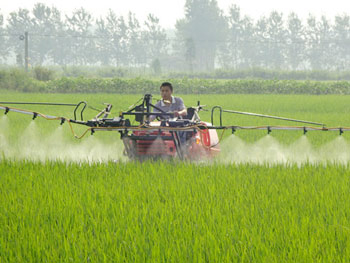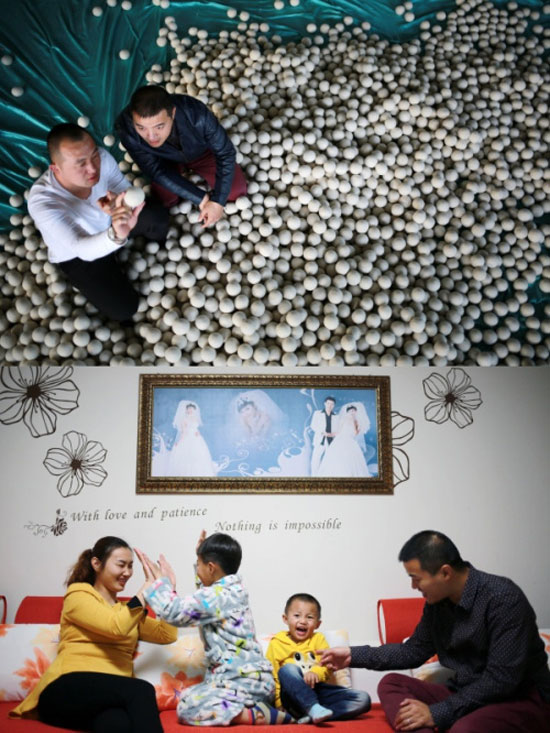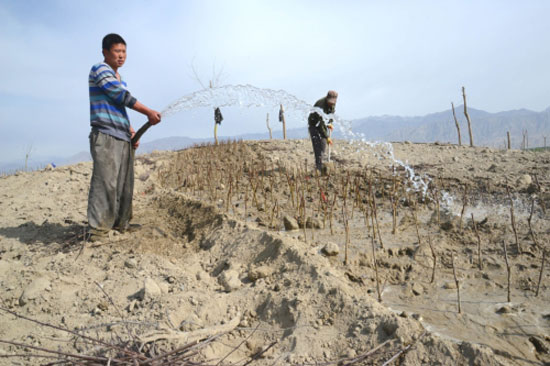2016 what are the key points for the prevention and control of major diseases and insect pests
Original title: technical plan for prevention and control of major crop diseases and insect pests in 2016

Control of diseases and insect pests (network map)
In order to implement the spirit of the National Agricultural work Conference, earnestly do a good job in the prevention and control of major crop diseases and insect pests in 2016, reduce the losses of diseases and insect pests, and promote zero growth in the use of pesticides, our center organized relevant experts to study and formulate technical programs for the prevention and control of major diseases and insect pests in rice, wheat, corn and potatoes in 2016. The plan is now issued to the stations (bureaus and centers) of plant protection (plant inspection and agricultural technology) in all provinces, autonomous regions and municipalities directly under the Central Government, the agricultural technology extension station of the production and Construction Corps, and the Agricultural Bureau of the Heilongjiang Provincial General Administration of Land Reclamation. Please take measures according to local conditions, earnestly implement various prevention and control technical measures, and make positive contributions to ensuring the safety of China's agricultural production this year.
Rice--
According to the forecast of the National Agricultural Technology Center, the occurrence of rice diseases and insect pests in China will be more serious in 2016, with an area of 1.57 billion mu. Among them, rice planthopper and rice leaf roller reoccurred in a wide area, rice stem borer concentrated damage was prominent, rice blast and false smut were high, rice black-streaked dwarf disease was rising in southern China, rice bacterial blight and bacterial base rot occurred more seriously in some areas. In order to do a good job in the prevention and control of major rice diseases and insect pests in 2016, this program is specially formulated.
Prevention and control target
The disposal rate of major diseases and insect pests has reached more than 90%, the overall control effect has reached more than 85%, the damage rate of diseases and insect pests has been controlled within 5%, the application area of green prevention and control technology has reached 24%, and the specialized unified control area has reached 34%. The use of chemical pesticides in rice decreased by more than 10%.
Prevention and control strategy
Take the paddy field ecosystem as the center, strengthen regional management, focus on major diseases and pests and re-occurrence areas, cultivate the damage control ability of the paddy ecosystem, give priority to the use of green prevention and control technologies such as fitness cultivation, pest-resistant varieties and biological control, strengthen the pest control role of natural enemies, safe and rational use of drugs, prohibit the use of pesticides containing pyrethroids, and integrate green prevention and control with professional unified control. To ensure the yield and quality of rice and the ecological security of rice fields.
Prevention and control measures
(1) key points of prevention and control in different areas
1. South China rice region. Including double-cropping rice planting areas in Guangdong, Guangxi, Fujian and Hainan, focusing on the control of rice planthopper, rice leaf roller, rice blast, sheath blight, rice false smut, virus disease, and pay attention to the prevention and control of rice stem borer, rice stem borer and bacterial leaf blight.
two。 Rice region in the middle and lower reaches of the Yangtze River. Including Hunan, Jiangxi, Hubei, Anhui, Jiangsu, Zhejiang and Shanghai single-cropping and double-cropping rice mixed planting areas and single-cropping rice planting areas, focusing on the prevention of rice blast, rice false smut and virus disease. control rice planthopper, Chilo suppressalis, rice leaf roller and sheath blight, and locally control rice thrips, stem borer, rice stem borer and bacterial blight.
3. Southwest rice region. Including Yunnan, Guizhou, Sichuan, Chongqing and southern Shaanxi single-cropping rice planting areas, focusing on the prevention of rice blast, false smut and southern rice black-streaked dwarf disease, prevention and control of rice planthopper, rice leaf roller, stem borer and sheath blight, pay attention to the control of armyworm and bacterial blight.
4. Huang-Huai rice region. Including Jiangsu and northern Anhui, Henan and Shandong single-cropping rice planting areas, focusing on the prevention and control of rice blast, rice false smut, black-streaked dwarf disease, rice planthopper, rice stem borer, sheath blight, rice leaf borer, Chilo suppressalis and striped leaf blight.
5. The northern rice region. Including Heilongjiang, Jilin, Liaoning, Hebei, Tianjin, Inner Mongolia, Ningxia single cropping rice planting areas, focusing on the prevention of rice blast, evil seedling disease, rice false smut, prevention and control of rice stem borer and sheath blight.
(2) main technical measures
1. Rice planthopper. The rice areas of South China, Southwest China and the middle and lower reaches of the Yangtze River focus on the control of brown planthopper and white-backed planthopper, while the Huang-Huai rice region focuses on the control of white-backed planthopper and gray planthopper. Give priority to the selection of resistant (tolerant) lice varieties, apply ecological engineering damage control technology, and minimize the use of pesticides in the early stage of the field, so as to give full play to the damage control role of natural enemies. The key point of chemical control is in the middle and later stage of rice growth, and the control indexes are 800-1000 at booting stage and 1200-1500 at heading stage, giving priority to selecting varieties that are relatively safe to natural enemies, spraying the base of rice clump at the peak of young nymphs, advocating the use of high content single agent and avoiding the use of low content compound agent.
two。 Rice leaf roller. Give full play to the self-compensation ability of rice in the early stage of growth, apply ecological engineering technology to improve the damage control of natural enemies, focus on the prevention and control of the main damage generation, and protect functional leaves. The sex pheromone cluster trapping technique was adopted in the initial stage of migration, and the population of rice borer Trichogramma was released during the peak period, and the biological pesticides such as Bacillus thuringiensis, cabbage armyworm NPV, Beauveria bassiana and Brevibacterium were sprayed uniformly in fine spray from the peak of egg hatching to the peak of young instar larvae. If chemical agents are needed, the control indexes are 150 leaf tips of 100 clump rice at tillering stage and 60 leaf tips of 100 clump rice at panicle stage.
3. Borer. The overwintering generation borer pupation stage in spring ploughed and irrigated the field to reduce the number of insect sources; the sex pheromone cluster trapping technique was applied from the end of the overwintering generation pupae, the rice borer Trichogramma was released at the peak of moth, and Bacillus thuringiensis was applied at the beginning of egg hatching. Chemical control of Chilo suppressalis, when the withered sheath rate reaches 8% to 10% or the withered sheath plant rate to 3% at the tillering stage, the panicle stage focuses on the control of rice fields with a large amount of residual insects in the previous generation during the peak egg hatching period, and the contemporary rice stem borer egg incubation period coincides with the rice break heading stage; control of rice stem borer, application at the early stage of rice breaking and heading, focus on the control of rice fields with 40 eggs per mu.
4. Rice blast. Plant disease-resistant varieties, diversify varieties, do a good job in seed disinfection, and avoid partial and late application of nitrogen fertilizer. Focus on the implementation of appropriate chemical prevention measures, transplanting seedlings with medicine in the frequent occurrence area, applying pesticide to control leaf blast when disease spot is first seen in the field at tillering stage, preventing panicle blast 3-5 days before breaking, and applying pesticide for the second time after 7 days when the disease is suitable for climate. Advocate the use of high content single agent and avoid the use of low content compound agent.
5. Sheath blight. Strengthen the management of fertilizer and water, do a good job in fitness cultivation, and sun up the field at the end of tillering. The focus of chemical control is from the end of tillering to booting and heading stage, when the disease cluster rate in the field reaches 20%.
6. Rice false smut. Plant disease-resistant varieties and apply fertilizer reasonably to improve the disease resistance of rice. The prevention should be focused on the rice at the end of booting stage, that is, 10-15 days before the break, and the second time after 7 days in case of rainy weather.
7. Rice black-streaked dwarf disease and sawtooth leaf dwarf disease in southern China. Planting disease-resistant varieties; prevention in the seedling stage of single-cropping rice and late rice and in the early stage of Honda, focusing on seed dressing or soaking, concentrated seedling raising, non-seed treatment seedlings covered with anti-insect net or non-woven cloth to cultivate non-toxic strong seedlings; seedling transplanting with medicine; timely control of rice planthopper in seedling field and early Honda. In the rice planthopper breeding area all the year round, the late rice was ploughed immediately after harvest to reduce the number of winter virus host plants such as ratooning rice and falling valley rice.
8. Striped leaf blight and black striped dwarf. Plant disease-resistant varieties and postpone the sowing date appropriately. Seed dressing or soaking with insecticides, concentrated seedling cultivation covered with anti-insect net or non-woven cloth, non-toxic strong seedlings, transplanting seedlings with medicine. Pay attention to the control of pre-cropping wheat field, field edge weeds, seedling field and early transplanting gray planthopper.
9. Bacterial blight. Plant disease-resistant varieties, focus on seed disinfection, cultivate disease-free and strong seedlings, strengthen water and fertilizer management, anti-flooding, anti-channeling irrigation, chemical control center comprehensive control measures. In the areas with frequent occurrence of diseases, the susceptible varieties were treated with pesticides in time after typhoons and rainstorms.
The main technology of green prevention and control and specialized unified defense rule
Related
- A course of planting techniques and methods on how to grow carrots
- How to plant the latest tulips?
- Is it better to pick tea in the morning or in the afternoon? When is the best time for tea to be picked? what is the third or fifth tea?
- Launch Yuanxiao Happy combination Haocha + Tea Yuan healthy Taste
- Penghu Tourism "Fireworks 20 Parade with You"
- 2022 West Lake Happiness holds "Digital Revitalization Voucher" and draws iphone13 and laptop.
- Banqiao Fuzhou social houses are designed to change start-up combined with police elimination to create a safe and livable environment
- The convenient measure of "mechanical weeding" in Xinbei has been abused and the Agriculture Bureau has imposed heavy penalties on the illegal land consolidation.
- Changgeng University Joins Hands with Four Memory Factories to Rescue Memory Talent Shortage
- The list of Taiwan's top 100 MVP managers is listed by the Director-General of the Farmers' Association of Sanxia District.



